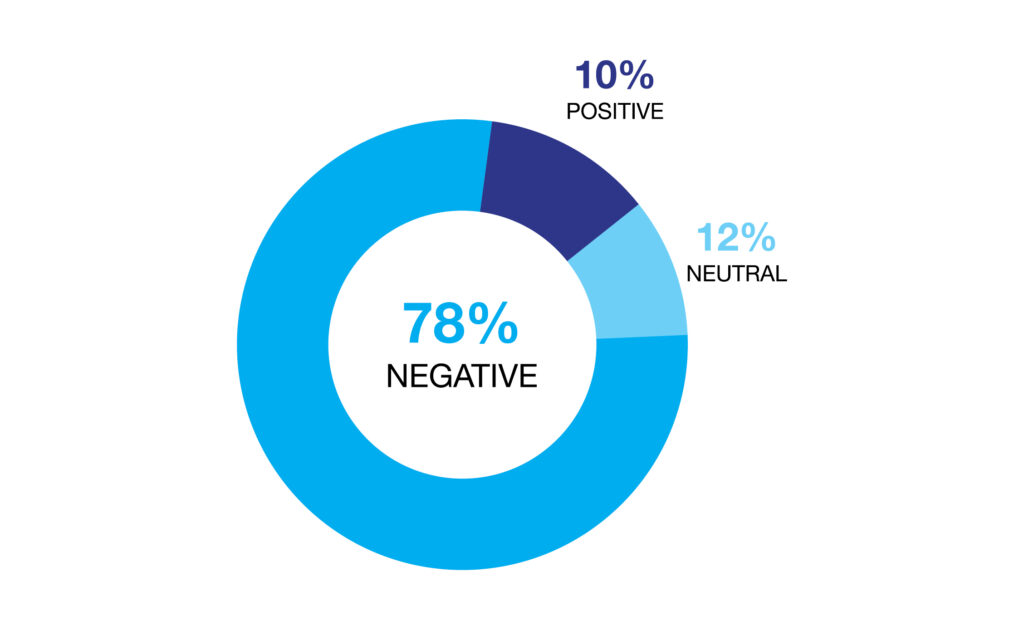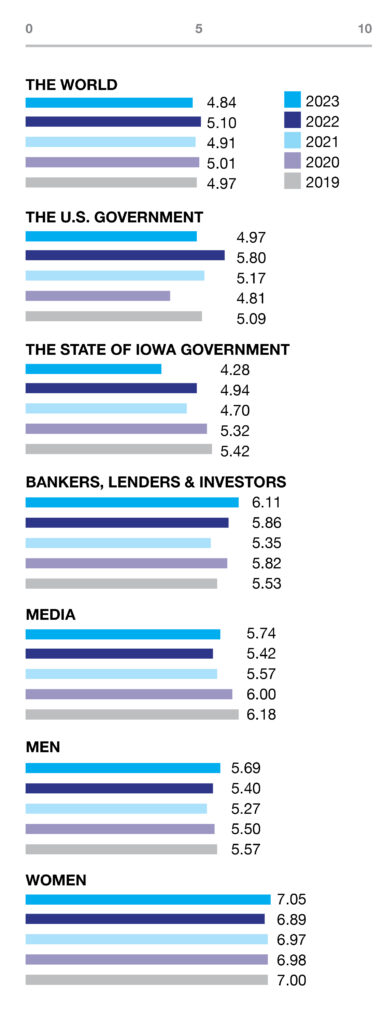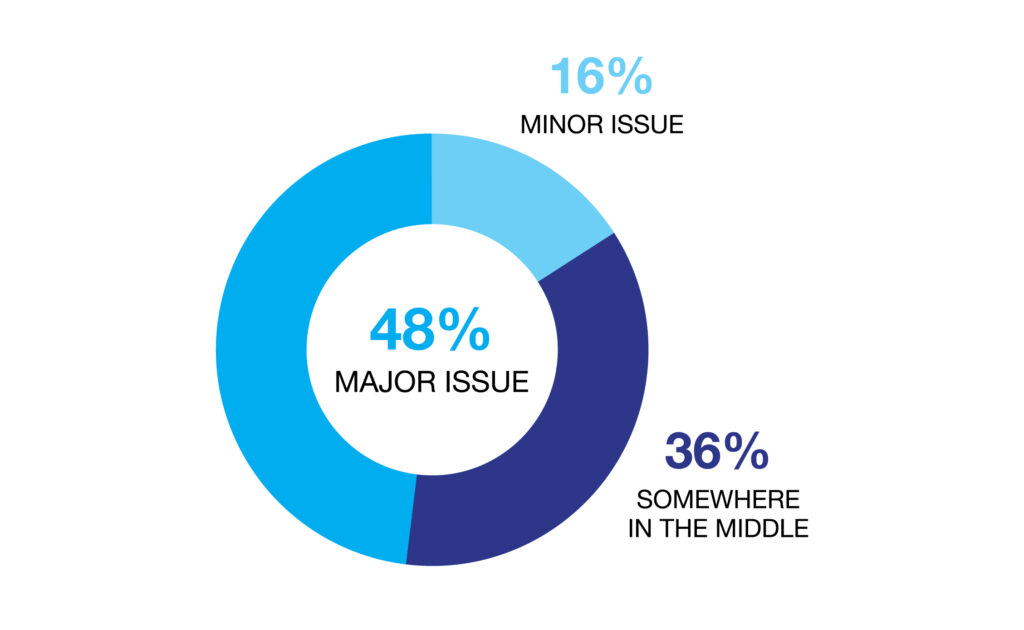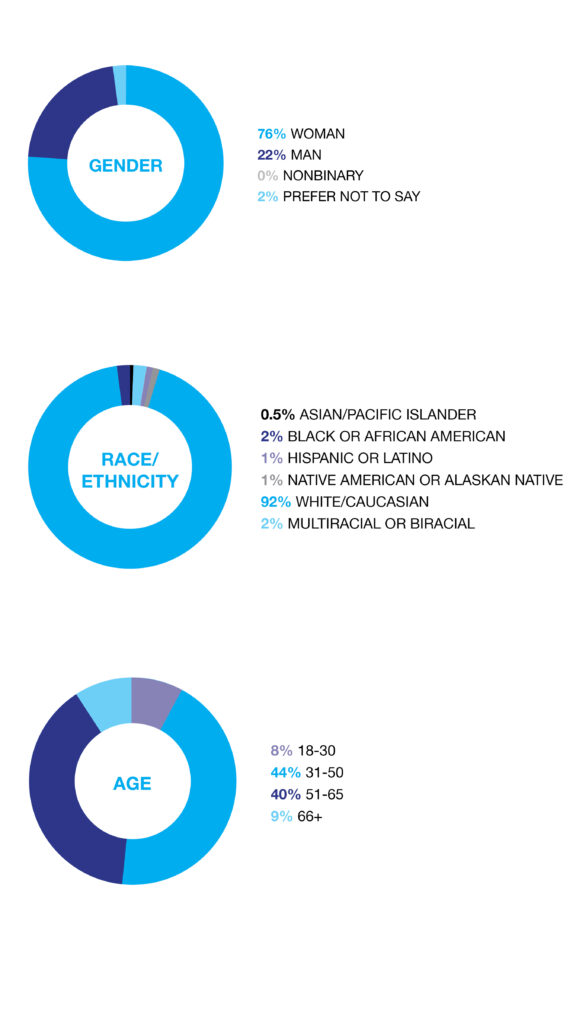Annual Fearless survey: Awareness of gender equity issues is improving post-pandemic, now action needs to happen
By Emily Kestel

There may never be a definitive answer to what gender equity truly looks like in practice.
Countless factors are at play when discussing women’s equality: equal pay, representation in leadership positions and political office, an ability to safely and affordably raise a child – or the ability to choose not to – freedom from gender-based violence, being seen as equal under the law. The list goes on.
What we do know is that women in Iowa have yet to experience equity with their male counterparts in many aspects of life.
Since 2016, the Business Record has published a survey dedicated to highlighting issues that women face in Iowa, both at work and at home. While not scientific, we believe the results illustrate current opinions and experiences of a variety of people across the state.
In this year’s survey, we asked respondents to rank how close they perceive women are to achieving full equality with men on a scale of 0 to 100. The average number was 53.
The following responses and analysis aim to provide a wide-angle view on some of the biggest issues that respondents identified, including child care, pay equity, representation of women in leadership and political positions, and treatment at work.
More topics will be covered in depth in future Business Record and Fearless stories. Sign up to receive the weekly Fearless newsletter to be the first to read the subsequent analyses.
Note: Due to rounding, some percentages may not add up to exactly 100. Written responses have been lightly edited and condensed for clarity.
— Emily Kestel, Fearless editor
Who took the survey?
A total of 225 people participated in the online survey between Feb. 20 and March 10.
What do you consider to be some of the biggest advancements of women in the last year?
Of the 61 responses to this question, 10 included an answer along the lines of there being no examples of women’s advancement in the last year. One person put it this way: “Honestly, in the last year it seems like women have moved back, pushing women into more traditional gender roles.” However, individual milestones of women’s advancement within the last year were aplenty. Off the top of my head: Two women were the major party nominees for Iowa governor for the first time, Wartburg College and Grand View University are being led by women for the first time, and women’s faces are now appearing on quarters. (Want to see more historic gains and milestones of women from the last year? Check out an archived Fearless newsletter.)
- Bringing visibility to issues that affect women in their daily lives.
- More flexibility with work, and a greater awareness and acceptance that women carry a big portion of the household responsibilities – and accommodating that is a good thing for employee health.
- Local women candidates are proving that they can win, and our city councils, school boards, state Legislature and statewide elected officials are becoming more gender balanced.
- Strong women are running multiple state agencies. We have a governor who is getting her agenda done. Half of our congressional delegation is women. Our Senate president and House minority leader are women. What’s more, women are running and leading in both parties.
- In Iowa? Girls wrestling! Caitlin Clark and women’s basketball teams selling out arenas!
- The appointment of Ketanji Brown Jackson to the U.S. Supreme Court.
- More women are breaking the glass ceiling and advancing into executive-level careers.
What are the biggest challenges, obstacles or barriers that you and other women face at work?
As I mentioned in last year’s survey analysis, women continue to face the same barriers at work that they have for the last several decades, including sexism, lack of representation, pay inequity and access to adequate parental leave. Women hold fewer than a third of C-suite positions in Iowa’s private sector. As a group, women are earning 77 cents for every dollar earned by white men.
- There continues to be a significant wage gap between men and women, and especially women of color. Additionally, when women have to take leaves to raise families, they lose out on months or years of retirement funds and money toward Social Security. Those benefits should continue to grow at a rate for women who choose or have to stay home with children or care for elderly parents.
- Women are often torn at work because they carry more load at home. This became particularly evident during COVID, where women were the people who lost ground at work because they had to be home teaching their children. Once you lose ground, it’s hard to make up.
- At my company, the total number of women outnumber male employees. However, women are not represented well in senior leadership positions, and women are promoted at significantly lower rates than men.
- Access to affordable child care remains a tremendous barrier after decades of recognizing this problem. It pushes many women to choose part-time work that has long-term ramifications for their career.
- Not having flexibility to manage work around life’s schedule, kids, etc. Feeling like we need to do more to “make up” for any flexibility we do have for juggling life. The pressure to keep up all the things at home with the antiquated belief that women need to manage all home things regardless of whether they also work outside the home.
- Men don’t take women seriously. Women don’t take women seriously. It’s still so deeply ingrained that I will even see powerful women accidentally do the exact things they struggled against themselves.
- Legislation that undermines women’s rights and undermines Iowa’s gender balance requirements for government boards. This is taking place outside of the workplace; however, the tenor and the attitude toward women seeps into the workplace.
What are the biggest challenges, obstacles or barriers that you and other women face outside of work?
One word kept jumping out at me when reading through all of the responses: Expectations. Historically, women have been the default primary caregivers of their family, while their partners – most often men – would be the ones bringing home the bacon. Nowadays, women are expected to “do it all,” by having a successful career on top of running a functional and happy household.
- It’s difficult to be everything you want to be. Working moms love their children but many of us also love the work we do. Sometimes it’s hard to fit somewhere – judged by those who stay home and judged by those who opt for career over family. It’s an old problem, but it’s still out there.
- Expectations of being able to manage a full-time career and still be the primary caretakers for children, household duties, volunteer opportunities, etc. Men get so much credit when they are devoted children’s team coaches, volunteer board members, or sharing in household responsibilities; women are expected to do it all, so it’s often taken for granted.
- Throughout most of history, women relied on men for their physical and financial survival. As the narrative shifts, women no longer “need” men in these ways, which requires men to have more to offer than just strength and money. I think a good starting place would be for more men to attend therapy – healing and growing so they can offer emotional maturity and support to potential partners.
- Lack of bodily and reproductive autonomy.
- For me, it is being judged for not being married or having children.
- Safety from abusive partners is a huge issue in our community.
Do you believe that the U.S. Supreme Court’s decision last year to overturn Roe v. Wade, which protected the constitutional right to an abortion, will have a positive, negative or neutral effect on women’s advancement and role in society?

- This law is taking choice away from women, while doing nothing to address the underlying reasons why abortions are sought in the first place. These include the lack of access to affordable or reliable birth control, poverty, culturally accepted sexual norms and a broken child support system.
- When you take away rights to our bodies it sets us back. It has to, right? I personally do not like the option of abortion at all, but I will not take that right away from any woman. There are so many circumstances that not everyone could even imagine. Women deserve the right to choose and protect themselves.
- The government should not tell anyone what to do with their own body. People should be allowed to decide for themselves.
- To be full participants in society, women must control their own bodies.
- Many more female babies will hopefully live!
- A woman’s advancement in society is up to her as an individual, not a law regarding abortion.
Rate how supportive you perceive these institutions/groups to be of women in business:
This question has appeared in every gender issues survey that the Business Record has published. This year, we decided to look at the previous five years to see what progress has been made, if any. The ranking reflects an average based on respondents assigning each area a value from 1 to 10, with 1 not being very supportive and 10 being very supportive. We also asked respondents to explain why they chose the number they did.

The world: 4.84/10
- The percentage of large businesses owned and run by women is still small compared to men.
- Women outside the Western world are always under attack.
- While the U.S. is extremely advanced in how they value women in the workplace, in many countries women are still fighting for very basic rights.
- It varies from country to country. There are cultures that hold women with high regard and there are some that do not.
The U.S. government: 4.97/10
- There has still not been a woman president and men still dominate seats throughout government.
- The general buffoonery of Congress.
- The U.S. government does not see women and children as major focuses of growth and development.
- No paid leave, no universal child care.
The state of Iowa government: 4.28/10
- We have a female governor!
- Though we have a female governor, smaller local governments are male-dominated. My local city council has no women on it.
- Gov. Reynolds returned money that would have been crucial in fixing the child care deserts in rural Iowa.
- I feel we are moving in the wrong direction and focusing on policies that are politically divisive instead of removing roadblocks for women to expand their careers.
Banks/lenders/investors: 6.11/10
- Federal laws against discrimination have helped move policies along.
- I feel like this has improved in the last several years as people recognize the opportunities that exist with business women.
- I feel this field is getting better with women representation.
- From my perspective, lending to male-owned companies is much more prevalent than women-owned companies.
Media: 5.74/10
- It is improving – take for instance, a realistic Victoria’s Secret model.
- Unrealistic beauty standards are pushed on women and young girls, and are damaging to mental and physical health.
- I now see more female journalists and TV personalities in the media.
- The media does a nice job of elevating women’s stories.
- I feel we take a step forward, and then the media takes us back three steps. Reality shows depict women in an unintelligent and out-of-control way.
- The media sends many mixed messages, especially to young women.
Men: 5.69/10
- I am fortunate enough that I am surrounded by men that are more inclusive and supportive.
- The men in my personal life are very supportive. At work, I would say it’s 50-50.
- I think most men want to be supportive, but don’t know where or how to start.
- It depends on the man and their willingness to admit women are equal.
Women: 7.05/10
- There are women in powerful positions that are not supportive.
- Women are overly competitive with other women because of the lack of opportunity. Women fight among themselves for access to the limited resources/opportunities available.
- There is somewhat of a 50-50 split here. Some women are competitive. Some women are very encouraging and supportive.
How big an issue do you perceive pay inequity in Iowa to be?

The gender pay gap has barely improved in the last 20 years. In 1996, women working full time were earning 75 cents to the white man’s $1. Today, women working full time earn 84 cents, but when you take into consideration both women who work part time and those who work full time, which is said to be more representative of female employment, that figure is 77 cents. Recent data from the Bureau of Labor Statistics shows that Iowa women make 83.7% of what men make. What’s more, the gender pay gap is visible in virtually every occupation when comparing average wages for men and women, even in industries dominated by women, like education, personal care, health care support and social services. About two-thirds of survey respondents said businesses and organizations should implement salary transparency policies to help address pay discrepancies. Look for more coverage on this topic in future Fearless stories.
- There are large companies that are making strides to be more transparent and pay their women employees fairly, but the inequity that comes with certain careers that are traditionally held by women (teaching, nursing, child care, etc.) having a much lower overall salary desperately needs to be addressed.
- Why are female-dominated roles not paid what male-dominated roles are paid?
- Women still need to learn how to ask for what they’re worth. Salary transparency in companies would help this issue significantly.
- Being in human resources for many years, I’ve seen what people make from the top to the bottom. While there is definitely inequity between men and women that needs to be resolved, there is equally an issue in my opinion with respect to the delta between the executive-level compensation and those in other roles within a given company.
- We have such a tight job market that women are making gains in pay equity, so I don’t think it is the primary issue.
What does the ideal family leave policy look like?
Despite recent efforts in Congress, the U.S. remains one of a few countries that don’t offer some form of parental or family leave at the national level. Thus, it’s up to states and individual businesses and organizations to create policies for time off to care for a new child or sick family member.
The following comments were pulled from the survey questions “What, if any, barriers need to be addressed when it comes to workplace inclusion of those who are pregnant, those whose partner is pregnant or those who are going through the adoption process?” and “What does the ideal family leave policy look like?”
In a question that asked how many weeks of paid family leave parents should be entitled to, the most common answer for both the birthing and nonbirthing parent was 12 weeks. Nearly 20% of the 84 respondents said the birthing parent should get 20 or more weeks.
- Family leave should be for all kinds of things, not just children. We need to be more accepting of people who need to take [the Family and Medical Leave Act] for the care of a partner or parent. Those folks feel just as much pressure to return to work early as parents do. We should make it easier for people to take care of their families, no matter what stage of life they are in.
- Ask your employees what they need and do what you can to accommodate that. Paid leave. More than six weeks.
- The birthing parent should be allowed at least six months of fully paid parental leave without having to burn vacation and sick leave, to be used as they see fit from the time they begin their pregnancy until their child is 6 months old. They should also be allowed the ability to scale back to full-time work for the six additional months (50% time for 50% pay, 75% time for 75% pay, etc.) without endangering their positions. Nonbirthing parents should be allowed three months of time to be used within the first year of a child’s life, but not have to be used all at once.
- Use sick and vacation time first. Then receive short-term disability covered by the employer and state to ensure up to 12 weeks of full pay for new parents.
- Paid parental/guardian leave should be more widely available and supported. Small and medium-size businesses should be able to receive grants or buy into state-sponsored short-term leave insurance to provide the benefits.
- A national law mandating parental leave is so needed. Without that, the lowest wage earners are making impossible choices about how to balance caring for and bonding with their child, making enough money to feed, house, and support their child, and allowing their body to recover from physical impacts of childbirth and lack of sleep.
- An understanding that maternity leave is not a vacation. Oftentimes, we are forced to work ahead.
- We need to do more work about helping women transition back into work by making the workplace more flexible for all, regardless of parenting status.




